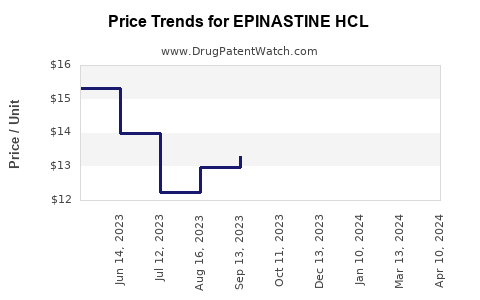Drug Price Trends for EPINASTINE HCL
✉ Email this page to a colleague

Average Pharmacy Cost for EPINASTINE HCL
| Drug Name | NDC | Price/Unit ($) | Unit | Date |
|---|---|---|---|---|
| EPINASTINE HCL 0.05% EYE DROPS | 60505-0584-01 | 13.40440 | ML | 2024-04-17 |
| EPINASTINE HCL 0.05% EYE DROPS | 62756-0329-90 | 13.40440 | ML | 2024-04-17 |
| EPINASTINE HCL 0.05% EYE DROPS | 51991-0836-75 | 13.40440 | ML | 2024-04-17 |
| EPINASTINE HCL 0.05% EYE DROPS | 70069-0008-01 | 13.40440 | ML | 2024-04-17 |
| EPINASTINE HCL 0.05% EYE DROPS | 51991-0836-75 | 14.50175 | ML | 2024-03-20 |
| EPINASTINE HCL 0.05% EYE DROPS | 62756-0329-90 | 14.50175 | ML | 2024-03-20 |
| >Drug Name | >NDC | >Price/Unit ($) | >Unit | >Date |
Best Wholesale Price for EPINASTINE HCL
| Drug Name | Vendor | NDC | Count | Price ($) | Price/Unit ($) | Unit | Dates | Price Type |
|---|---|---|---|---|---|---|---|---|
| EPINASTINE HCL 0.05% SOLN,OPH | Golden State Medical Supply, Inc. | 51991-0836-75 | 5ML | 68.62 | 13.72400 | ML | 2023-06-15 - 2028-06-14 | FSS |
| >Drug Name | >Vendor | >NDC | >Count | >Price ($) | >Price/Unit ($) | >Unit | >Dates | >Price Type |


